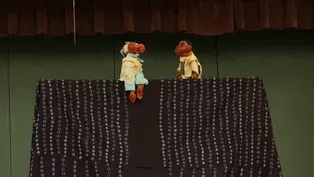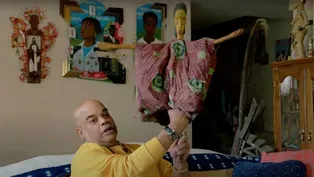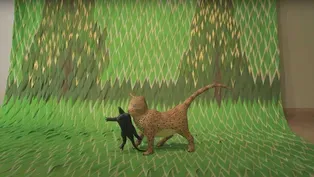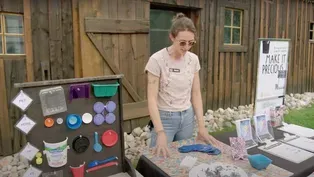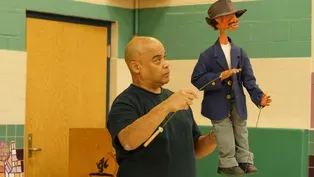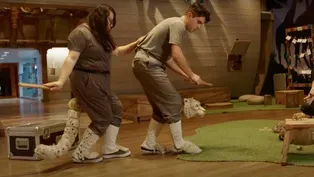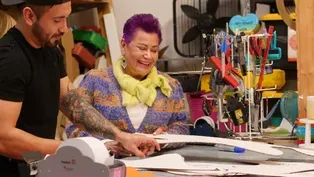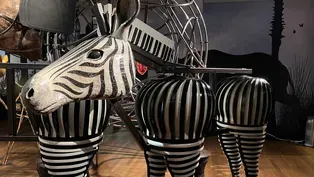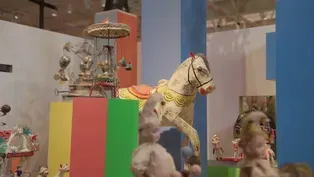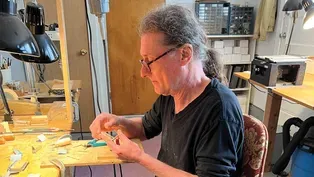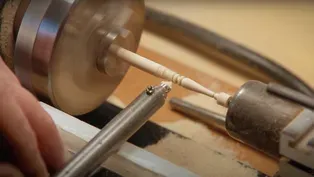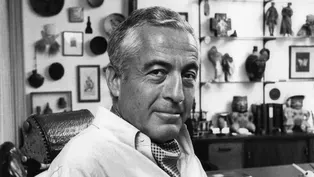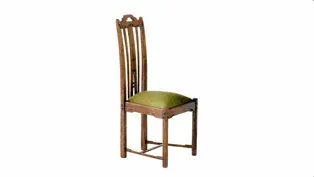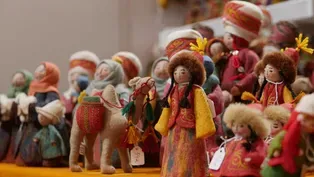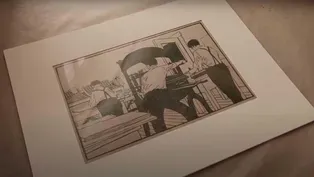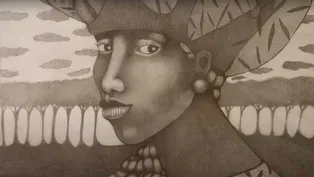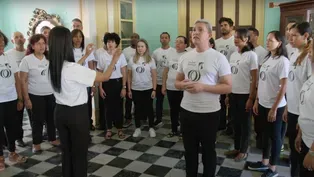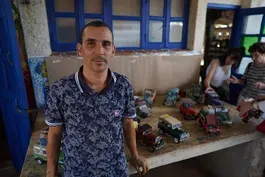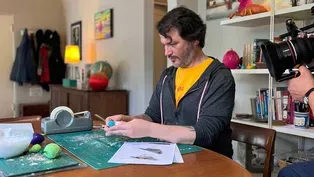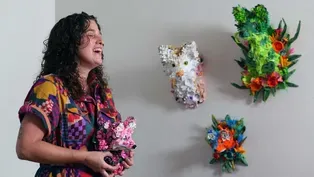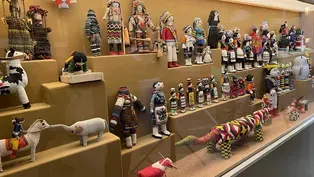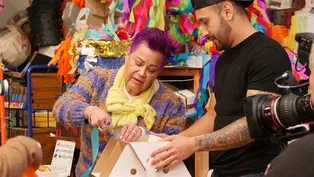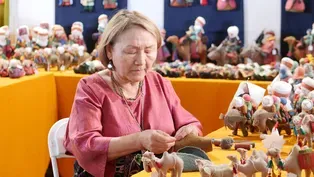
Woodblock print & marionette maker Gustave Baumann segment
Clip: Season 15 | 12m 16sVideo has Closed Captions
Multidisciplinary artist, Gustave Baumann, was deeply inspired by Santa Fe
Multidisciplinary artist, Gustave Baumann, who created paintings, woodblock prints and marionettes in the first half of the 20th century was deeply inspired by the landscape and people of Santa Fe. The city keeps his legacy alive today with their yearly Christmas marionette show. Segment from MINIATURES episode
Problems with Closed Captions? Closed Captioning Feedback
Problems with Closed Captions? Closed Captioning Feedback

Woodblock print & marionette maker Gustave Baumann segment
Clip: Season 15 | 12m 16sVideo has Closed Captions
Multidisciplinary artist, Gustave Baumann, who created paintings, woodblock prints and marionettes in the first half of the 20th century was deeply inspired by the landscape and people of Santa Fe. The city keeps his legacy alive today with their yearly Christmas marionette show. Segment from MINIATURES episode
Problems with Closed Captions? Closed Captioning Feedback
How to Watch Craft in America
Craft in America is available to stream on pbs.org and the free PBS App, available on iPhone, Apple TV, Android TV, Android smartphones, Amazon Fire TV, Amazon Fire Tablet, Roku, Samsung Smart TV, and Vizio.
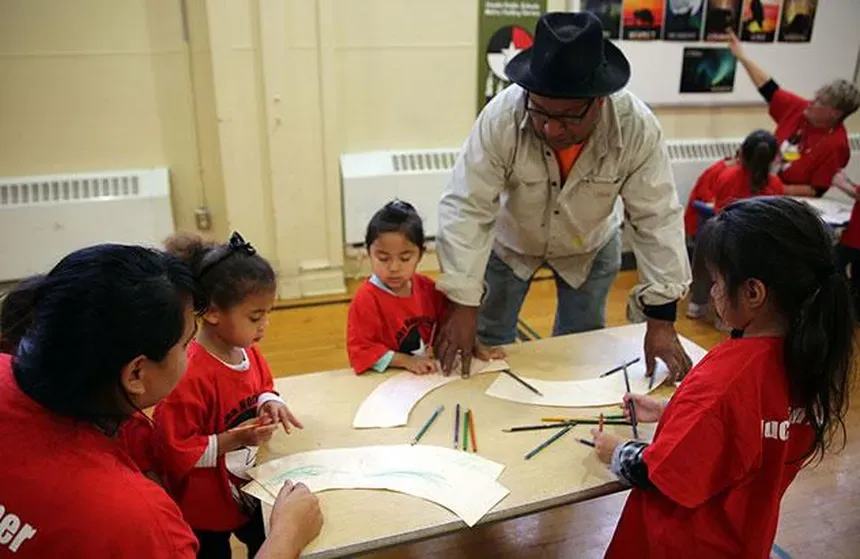
Education Guides
Download Craft in America education guides that educate, involve, and inform students about how craft plays a role in their lives, with connections to American history and culture, philosophies and science, social causes and social action.Providing Support for PBS.org
Learn Moreabout PBS online sponsorship♪♪ Gustave: Santa Fe is many things to many people.
I was among those that liked it, and now, with the passing of years, I have found no place I like better.
This is Gustave Baumann speaking.
Carmella: Gus Baumann took inspiration from so many aspects of life and art in Santa Fe, in the Southwest.
He was amazingly prolific.
I don't know where he found the time really to do everything.
He made woodblock prints, he made furniture, and then he created these incredible marionettes.
He brought a lot of beauty into a lot of people's lives and left a lasting legacy in Santa Fe.
♪♪ Thomas: Gustave Baumann was born in Germany in 1881.
His family moved to Chicago in 1891, so he was 10 years old.
At the age of 16, his father abandoned the family, so Gus went to work.
He started in an engraving company back before photography had worked its way into commercial printing, so images were still being carved by hand.
He really learned his craft.
Baumann heard about Nashville, Indiana, that there were other artists living there, and so gave up commercial art and then moved there in 1910.
Gustave: Brown County, Indiana, was just emerging from the log cabin period and holding on to the old ways.
The artists that lived there did so because it was an inexpensive and colorful place to work.
[Train chugging] [Whistle blows] Mark White: Gustave Baumann arrived in New Mexico in 1918.
He was lured to come to Santa Fe by the curator Paul Walter here at the museum.
Baumann was running short of funds, and so Paul Walter was able to secure a loan of $500, Walter being an officer of the nearby bank.
There were opportunities to exhibit at the new museum, and I think for him as a young artist, it was just a perfect environment.
Carmella: Santa Fe was a rough and tumble town, about 7,000 residents with a large population of Hispano peoples.
Most of the Pueblo peoples were still on their original homelands outside of Santa Fe.
Gustave: Here we have the Anglo frontier mingling with the Spanish heritage, both together functioning side by side with the original Indian inhabitants.
Folk art and handicraft flourished.
There's something in the mind of man that moves his hand to creative endeavor beyond the needs of livelihood.
♪♪ Thomas: We're in a reproduction of Gustave Baumann's studio.
It's filled with actual things that he used to create his woodcut prints.
He has all these pigments labeled.
We have his varnishes and the oil that he used.
This he would grind colors in.
The block that I'll be printing is an image of his Canyon Road studio carved in 1919.
♪♪ He put the work of the hand ahead of everything, so there is this sort of integrity to the craft.
♪♪ His process really starts with going out in nature and doing a drawing, turning it into a tempera painting, and then from that he would carve his series of blocks.
♪♪ Gustave: The Southwest has many surprises in store for the artist in search of inspirational material.
It will produce almost any kind of subject matter you might ask for.
Basic forms and color combinations that we like to think of as being exclusively modern have been here for a long time, waiting only to be recognized.
Thomas: He had his house built in Santa Fe.
0:04:59.560,1193:02:47.295 ♪♪ Everything inside is either carved or painted by Baumann.
In fact, he said, "I am a craftsman by choice and an artist by accident."
♪♪ Carmella: He met Jane at a Pueblo Indian dance on Christmas Eve.
She was an actress.
She was interested in creativity.
He was an artist.
They married, settled in the house, and eventually had one daughter Ann.
He was trying to create something that would interest his daughter and entertain her, and that was these marionettes.
Ann: The stage was there in the living room, and the marionettes hung on a rack behind.
You had the physical presence 24 hours a day of that stage and the marionettes.
I love the commedia dell'arte ones... Pierot... and Boom Boom the clown-- I liked him.
♪♪ When I was growing up, at Christmastime, we had the Christmas shows, which took over the whole house.
Mark: The marionette show was intended to amuse Ann and her friends, but it quickly morphed into a public show here at the museum in 1932.
Jane was one of the lead puppeteers, and it was something of an annual event, and it really did draw the community together.
Gustave and Jane Baumann continued the performances until 1959, and it was the Ann Baumann Trust that ultimately gave the marionettes to this museum.
♪♪ Maureen: I can't explain what it's like the first time you see one of his puppets, you know, just that "Oh, my God.
How did he make this?"
They're incredible.
There are 76 marionettes.
They were in terrible condition, which for a conservator who loves marionettes is really wonderful.
I couldn't wait to work on them.
I'm repairing the leg.
All the joins in the legs and the arms were made out of leather, and since the puppets are about 100 years old, sometimes they'll be hanging from the rack, and, you know, a leg will drop off.
The leather has to be replaced.
This puppet is the Tourist Lady, Lulu Clarkson.
She's got the little camera that he handmade for her and the visor.
She's always in search of a bathroom and can never find one, and you can tell by her eyes.
Ha!
♪♪ Baumann made each one have a real unique personality.
One of the first I worked on was Paint the horse, who goes with Pecos Bill.
The horse was in many, many pieces.
That was a good challenge.
There's duendis, New Mexican folk elves.
They're very mischievous and cause a lot of trouble.
The Green Dragon.
He's made with hoops almost like a slinky.
The fabric is suede.
Several of the characters came from real people.
Temperance the drunk.
He was the Santa Fe town drunk.
Gus' wife Jane.
She's made in a really pretty silk summer dress, stockings, underwear, everything.
Gus did himself as a real dandy with that Hawaiian print, and there's his daughter Ann when she was about five years old.
It's a family portrait, and for him, that was done with marionettes.
Mark: The museum will bring the marionettes out for exhibition, but they're a little too fragile to perform.
Marionette man: No, it is almost time for the big welcome back party.
Miguelito: See?
I knew we were invited.
Maureen: So they have six puppets reproduced that are exactly like the originals.
Miguelito: Whoa!
Burro: Hee-haw!
Mark: A show has been created using the reproduction marionettes.
Wow!
Hello, children.
I am so happy to see your bright, shining faces.
Mark: It was really a way to keep what had been a fantastic Santa Fe tradition alive.
Rosina: And we have to practice our dancing because I'm feeling... Marionette man: Yes, let us practice to see if we still have some of that old magic.
- Ha ha!
- Yes.
All right.
Here.
- Oh, oh, oh, oh, oh, oh, oh!
- Oh, oh, oh, oh!
Rosina: My goodness.
Barbara: The children don't look up above the marionette on the stage.
The human beings behind the marionettes cease to exist.
Miguelito: I know.
I'll put a spell on Rosina's broom so that she can't clean.
The voices do start to embody the actual marionette, and you'll just kind of get transported into the world.
Rosina: My broom has come to life!
Oh, my goodness!
It's chasing me across the room.
Oh, oh, oh!
Oh, my goodness.
[Laughter] You know, it takes a special kind of sensitivity to puppeteer these puppets.
It's like an extension of us.
Hey, Miguelito.
I'm so glad to see the both of you.
I hope you have been behaving very well.
Miguelito: Bye, Santo Nino.
So you got to really watch your wrist and really figure out their little quirks.
Apollo: Just a slight pull of the string, and you can change the emotion.
Miguelito: Oh, I just--ohh.
Apollo: Just a tilt of the hand, they'll go from joyous to sad.
Santo Nino: Children, should I wake them up?
Children: Yeah!
Santo Nino: OK. [Snoring] Wake up!
- Aah!
- Ohh!
Barbara: We are actually here because of and thanks to Gustave Baumann.
Through his mastery in carving the marionettes, he lives through these puppets, and therefore he lives through us.
[Chattering] Thomas: I put Baumann up against any artist-craftsman of the 20th century.
He was that good.
He was that important.
Carmella: And he's still here.
He's still a part of this place.
Gustave: If you feel that a story required a good, happy ending, there it was as good as any, and now we can all go home, and I'll follow you.
♪♪
Woodblock print & marionette maker Gustave Baumann segment
Video has Closed Captions
Multidisciplinary artist, Gustave Baumann, was deeply inspired by Santa Fe (12m 16s)
Underground Railroad, Not a Subway by Schroeder Cherry
Video has Closed Captions
Schroeder Cherry's puppetry performance, Underground Railroad, Not a Subway (25m 34s)
Schroeder Cherry's Civil Rights Childrens Crusade
Video has Closed Captions
Schroeder Cherry's puppetry performance, Civil Rights Childrens Crusade (9m 53s)
Schroeder Cherry's African Puppets
Video has Closed Captions
Artist, puppeteer, museum educator Schroeder Cherry on African puppets in his collection (2m 36s)
Roberto Benavidez on creating piñatas & "piñathkos"
Video has Closed Captions
Artist Roberto Benavidez speaks with curator and art historian on his piñatas & piñathkos (1m 49s)
Recycling plastic through Precious Plastic program
Video has Closed Captions
Sustainability coordinator on recycling plastic through their Precious Plastic program (54s)
Puppeteer Schroeder Cherry segment
Video has Closed Captions
How puppets can become vehicles of history & change: the work of Schroeder Cherry (10m 29s)
Puppeteering the snow leopard at Noah's Ark
Video has Closed Captions
Kinetic designer Chris Green works with Noah's Ark educators on puppeteering snow leopard (1m 47s)
Piñata maker Lorena Robletto segment
Video has Closed Captions
Lorena Robletto creates festive and creative piñatas with fair labor practices at her business, Amaz (6m 14s)
Noah's Ark at the Skirball segment
Video has Closed Captions
Noah's Ark animals made using repurposed materials & Skirball's puppet fest (12m 10s)
Multiple Visions: A Common Bond
Video has Closed Captions
Alexander Girard's folk art collection at Museum of International Folk Art Museum (1m 20s)
Miniaturist Mark Murphy segment
Video has Closed Captions
Woodworker makes tiny furniture: Meet miniaturist Mark Murphy (10m 31s)
Mark Murphy shows us his miniature furniture
Video has Closed Captions
Miniaturist Mark Murphy shows us his miniature 1/12th scale furniture (2m 19s)
Lloyd Cotsen & the Cotsen Children's Library segment
Video has Closed Captions
Lloyd Cotsen founded the Cotsen Children’s Library at Princeton University (5m 45s)
Video has Closed Captions
Lloyd Cotsen's collection of Chinese bronze mirrors, textiles, folk art, Japanese baskets (5m 22s)
International Guild of Miniature Artisans
Video has Closed Captions
Barbara Davis on the International Guild of Miniature Artisans and their Guild School (2m 27s)
International Folk Art Market segment
Video has Closed Captions
Meet artisans at the International Folk Art Market (9m 5s)
International Folk Art Market basket weaver
Video has Closed Captions
Master basket weaver Nelsiwe Dlamini at International Folk Art Market (1m 57s)
Gustave Baumann's Printing the Democrat woodblock print
Video has Closed Captions
Thomas Leech on Gustave Baumann's woodblock print, The Print Shop/Printing the Democrat (1m 10s)
Video has Closed Captions
JELMA curator Schroeder Cherry invites artist Espi Frazier to show her work in the gallery (1m 16s)
El Orfeon Santiago Chorus performance - bonus video from MINIATURES (1m 23s)
Cuban artist Leandro Gómez Quintero segment
Video has Closed Captions
Small scale model cars by Cuban artist Leandro Gómez Quintero (13m 43s)
Calder Kamin on Austin Creative Reuse
Video has Closed Captions
Artist Calder Kamin on how she discovered Austin Creative Reuse (1m 18s)
Artist Roberto Benavidez segment
Video has Closed Captions
Roberto Benavidez's piñatas inspired by medieval manuscripts (8m 24s)
Video has Closed Captions
Calder Kamin creates an art installation by reusing and recycling discarded plastic (10m 6s)
Alexander Girard's miniature folk art collection segment
Video has Closed Captions
Alexander Girard's miniature folk art collection hopes to evoke common humanity. (8m 6s)
Video has Closed Captions
Watch a preview of PLAY, streaming Dec 1, broadcast premiere Dec 29 (1m)
Video has Closed Captions
Watch a preview of MINIATURES, streaming Dec 1, PBS broadcast premiere Dec 29 (1m)
Providing Support for PBS.org
Learn Moreabout PBS online sponsorshipSupport for PBS provided by:

